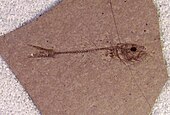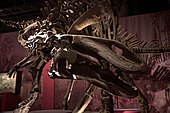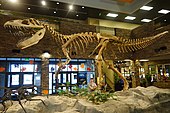1979 in paleontology
 From Wikipedia the free encyclopedia
From Wikipedia the free encyclopedia
| |||
|---|---|---|---|
| +... |
Paleontology or palaeontology is the study of prehistoric life forms on Earth through the examination of plant and animal fossils.[1] This includes the study of body fossils, tracks (ichnites), burrows, cast-off parts, fossilised feces (coprolites), palynomorphs and chemical residues. Because humans have encountered fossils for millennia, paleontology has a long history both before and after becoming formalized as a science. This article records significant discoveries and events related to paleontology that occurred or were published in the year 1979.
Bryophytes[edit]
| Name | Novelty | Status | Authors | Age | Type locality | Location | Notes | Images |
|---|---|---|---|---|---|---|---|---|
| Sp nov | Valid | Janssens | An aulacomniaceous moss. |
Fish[edit]
| Name | Novelty | Status | Authors | Age | Type locality | Location | Notes | Images |
|---|---|---|---|---|---|---|---|---|
| Sp nov | Valid | A libotoniid sandroller relative. |  |
Archosauromorphs[edit]
Data courtesy of George Olshevsky's dinosaur genera list.[4]
Non Avian Dinosaurs[edit]
| Name | Novelty | Status | Authors | Age | Type locality | Location | Notes | Images |
|---|---|---|---|---|---|---|---|---|
| Saito | informal name created by phonetic translation of the crylic for hadrosaur ("gadrosavr") into Japanese. |  | ||||||
| Gen et comb nov | Valid | A hadrosauroid. |  | |||||
| Wall & Galton |
| A pachycephalosaur, possible Junior synonym of Stegoceras. |  | |||||
| Valid | Horner & Makela | Upper Two Medicine Formation | Publication of Maiasaura renewed interest in the Two Medicine Formation.[9] |  | ||||
| Gen et sp nov | Junior synonym | Described as a pachycephalosaur, now considered an abelisaurid. |  | |||||
| Gen et sp nov |
| A hadrosaurid. | ||||||
| Valid | Bonaparte & Vince |
| An anchisaurian. |  | ||||
| Valid |  | |||||||
| Valid |
| A sauropod. |  | |||||
| Valid |  | |||||||
| Valid | ||||||||
| Valid |
|  | ||||||
| Gen et sp nov | Valid | A megalosaurid. |  | |||||
| Gen et sp nov | Valid |
| A possible Carcharodontosaurian. | |||||
| Valid | A sauropod. | |||||||
| Gen et sp nov | Valid | He | A basal neornithischian ornithopod. |
Birds[edit]
| Name | Novelty | Status | Authors | Age | Unit | Location | Notes | Images |
|---|---|---|---|---|---|---|---|---|
| Gen. nov. et Sp. nov. | Valid | An Accipitridae, this is the type species of the new genus. | ||||||
| Sp. nov. | Valid | An Anatidae. | ||||||
| Sp. nov. | Valid | An Anatidae. | ||||||
| Sp. nov. | Valid | An Anatidae. | ||||||
| Sp. nov. | Valid | Argentina: Centinale del Mar; | An Anatidae, transferred to the genus Callonetta Delacour, 1936 by Agnolin, 2006.[22] | |||||
| Sp. nov. | Valid | Subrecent | 5000 YBP (Years Before Present) | A giant Ardeidae, not formally described but a photo is published which keeps it from being a Nomen Nudum. | ||||
| Sp. nov. | Valid | Early Middle Oligocene | Described in the Catharthidae, transferred to Aves Incertae Sedis. | |||||
| Gen. nov. et Sp. nov. | Valid | A Dromornithidae, this is the type species of the new genus. | ||||||
| Sp. nov. | Valid | A Charadriidae. | ||||||
| Sp. nov. | Valid |
| A Strigidae, transferred to the genus Asio Brisson, 1760 by Mlíkovský, 1998.[27] | |||||
| Gen. nov. et Sp. nov. | Valid | Middle-Late Miocene | A Dromornithidae, this is the type species of the new genus. | |||||
Sp. nov. | Valid | A Caprimulgidae-nightjar. | ||||||
| Gen. nov. et Sp. nov. | Valid | An Anatidae. | ||||||
| Sp. nov. | Valid | A Corvidae, possibly a synonym of Corvus corone Linnaeus, 1758. | ||||||
| Sp. nov. | Valid | A Cuculidae. | ||||||
| Gen. nov. et Sp. nov. | Valid | A Spheniscidae, this is the type species of the new genus. | ||||||
| Sp. nov. | Valid | |||||||
| Sp. nov. | Valid | |||||||
| Sp. nov. | Valid | A Scolopacidae. | ||||||
| Gen. nov. et Sp. nov. | Valid | A Cathartidae. | ||||||
| Sp. nov. | Valid | A Glareolidae. | ||||||
| Sp. nov. | Valid | A Cathartidae. | ||||||
| Gen. nov. et Sp. nov. | Valid | A Dromornithidae, not certainly an Ilbandornis Rich, 1979. | ||||||
| Gen. nov. et Sp. nov. | Valid | A Dromornithidae, this is the type species of the new genus. | ||||||
| Gen. nov. et Sp. nov. | Valid | A Rallidae, this is the type species of the new genus. | ||||||
| Sp. nov. | Valid | A Rallidae. | ||||||
| Gen. nov. et Sp. nov. | Valid | Described in the Phasianidae, but transferred by Mlíkovský, 2002.[33] to Aves Incertae Sedis, this is the type species of the new genus. | ||||||
| Sp. nov. | Valid | A Scolopacidae. | ||||||
| Gen. nov. et Sp. nov. | Valid | A Falconidae. | ||||||
| Gen. nov. et Sp. nov. | Valid | Described as an Accipitridae, known only from a damaged distal end of a right tarsometatarsus, making it not possible to identify it, better treated as Aves Incertae Sedis, this is the type species of the new genus. | ||||||
| Gen. nov. et Sp. nov. | Valid | Early Miocene Czech Republic; Middle Miocene Germany | A Glareolidae, it is the type species of the new genus. | |||||
| Gen. nov. et Sp. nov. | Valid |
| An Otididae, it is the type species of the new genus. | |||||
| Gen. nov. et Sp. nov. | Valid | An Accipitridae, transferred to the genus Buteogallus Lesson, 1830 by Suárez et Olson, 2009,[35] this is the type species of the new genus. | ||||||
| Gen. nov. et Sp. nov. | Valid | An Anatidae, this is the type species of the new genus. | ||||||
| Gen. nov. et Sp. nov. | Valid | A Spheniscidae, this is the type species of the new genus. | ||||||
| Gen. nov. et Sp. nov. | Valid | A Scolopacidae, this is the type species of the new genus. | ||||||
| Gen. nov. et Sp. nov. | Valid | Early Middle Oligocene | Described in the Catharthidae, but the holotype is too fragmentary for identification so best treated as Aves Incertae Sedis. | |||||
| Sp. nov. | Valid | Early Middle Oligocene |
| An Anseriformes Incertae Sedis. | ||||
| Gen. nov. et Sp. nov. | Valid | Greybullian, Middle Wasatchian, Willwood Formation | Described as a Cathartidae, Houde 1988 placed it in the Lithornithiformes, Houde, 1988, Lithornithidae Houde, 1988,[38] it is the type species of the new genus. | |||||
| Gen. nov. et Sp. nov. | Valid ? | Early Middle Oligocene | MP 21-23 | An Anatidae, it is the type species of the new genus. | ||||
| Sp. nov. | Valid | A Rallidae. | ||||||
| Sp. nov. | Valid | Described as a Phasianidae, transferred to the genus Talantatos Reichenbach, 1852 and placed in the Cariamidae door Mlíkovský, 2002.[33] | ||||||
| Sp. nov. | Valid | Early-Middle Pleistocene | ||||||
| Sp. nov. | Valid | A Rallidae. | ||||||
| Gen. nov. et Sp. nov. | Valid | An Anatidae, it is the type species of the new genus. | ||||||
| Gen. nov. et Sp. nov. | Valid | An Ardeidae, it is the type species of the new genus. | ||||||
| Gen. nov. et Sp. nov. | Valid ? | Early Middle Oligocene | Described as an Eleutherornithidae, based on a fragment of a cervical vertebra, best treated as Aves Incertae Sedis, it is the type species of the new genus. | |||||
| Sp. nov. | Valid | A Cathartidae, not certain to be a Sarcoramphus Duméril, 1806. | ||||||
| Sp. nov. | Valid | A Scolopacidae. | ||||||
| Sp. nov. | Valid | |||||||
| Sp. nov. | Valid | An Ardeidae. | ||||||
| Sp. nov. | Valid | |||||||
| Sp. nov. | Valid | A Thinocoridae. | ||||||
| Sp. nov. | Valid | A Scolopacidae. | ||||||
| Sp. nov. | Valid ? | The holotype is a heavily eroded proximal part of a left humerus, best placed in Passeriformes Incertae Sedis. | ||||||
| Gen. nov. et Sp. nov. | Valid ? | A Phalacrocoracidae, this is the type species of the new genus. | ||||||
| Gen. nov. et Sp. nov. | Valid | A Charadriidae, this is the type species of the new genus. |
Plesiosaurs[edit]
| Name | Novelty | Status | Authors | Age | Type locality | Location | Notes | Images |
|---|---|---|---|---|---|---|---|---|
| Gen et sp nov | Valid | Yadagiri & Ayyasami | Either a Plesiosaur or Stegosaur |
Synapsids[edit]
| Name | Novelty | Status | Authors | Age | Type locality | Location | Notes | Images |
|---|---|---|---|---|---|---|---|---|
| Gen et sp nov | valid | Bown | An Omomyid primate | |||||
| Gen et sp nov | valid | Bown | An Omomyid primate | |||||
| Gen et sp nov | valid | Bown | An Omomyid primate |
Expeditions, field work, and fossil discoveries[edit]
- While volunteering for field work on a team led by Philip Currie, Darren Tanke learned about the lost "Eoceratops" first excavated by William Edmund Cutler. Tanke would later rediscover the specimen in London's Natural History Museum.[43]
References[edit]
- ^ Gini-Newman, Garfield; Graham, Elizabeth (2001). Echoes from the past: world history to the 16th century. Toronto: McGraw-Hill Ryerson Ltd. ISBN 9780070887398. OCLC 46769716.
- ^ Janssens, J.; Horton, D.G.; Basinger, J. (1979). "Aulacomnium heterostichoides sp. nov., an Eocene moss from south central British Columbia". Canadian Journal of Botany. 57 (20): 2150–2161. doi:10.1139/b79-268.
- ^ Wilson, M.V.H. (1979). "A second species of Libotonius (Pisces: Percopsidae) from the Eocene of Washington State". Copeia. 1979 (3): 400–405. doi:10.2307/1443214. JSTOR 1443214.
- ^ Olshevsky, George. "Dinogeorge's Dinosaur Genera List". Archived from the original on 2011-07-15. Retrieved 2008-08-07.
- ^ Saito, T. 1979. Wonder of the World's Dinosaurs. Kodansha Publishers, Tokyo (Plate 71).
- ^ Brett-Surman, M.K. 1979. Phylogeny and paleobiogeography of hadrosaurian dinosaurs. Nature 277: pp. 560-562.
- ^ Wall, W P. and P.M. Galton. 1979. Notes on pachycephalosaurid dinosaurs (Reptilla: Ornithischia) from North America, with comments on their status as ornithopods. Can. J. Earth Sci. 16: pp. 1176-1186.
- ^ Horner, J.R.; Makela, R. (1979). "Nest of juveniles provides evidence of family structure among dinosaurs". Nature. 282 (5736): 296–298. Bibcode:1979Natur.282..296H. doi:10.1038/282296a0. S2CID 4370793.
- ^ Trexler, D., 2001, Two Medicine Formation, Montana: geology and fauna: In: Mesozoic Vertebrate Life, edited by Tanke, D. H., and Carpenter, K., Indiana University Press, pp. 298–309.
- ^ Sues, H.-D.; Taquet, P. (1979). "A pachycephalosaurid dinosaur from Madagascar and a Laurasia-Gondwanaland connection in the Cretaceous". Nature. 279 (5714): 633–635. Bibcode:1979Natur.279..633S. doi:10.1038/279633a0. S2CID 4345348.
- ^ Dong, Z. 1979. Cretaceous Dinosaurs of Hunan, in Mesozoic-Cenozoic Redbeds of Hunan. Palaeontologica Sinica: pp.346-347.
- ^ Bonaparte J.F. and M. Vince. 1979. El hallazgo del primer nido de dinosaurios triasicos, (Saurischia, Prosauropoda), Triásico superior de Patagonia, Argentina. Ameghiniana Revista de la Asociación Paleontológica Argentina 16 (1-2): pp. 173-182.
- ^ Dong, Z. 1979. The Cretaceous dinosaur fossils in southern China. In: Mesozoic and Cenozoic Red Beds in Southern China. Inst. Vert. Paleontol. Paleoanthropol. Nanjing Geol. Paleontol. Inst. Sci. Press, Beijing: pp.342-350.
- ^ a b c Bonaparte, J.F. (1979). "Dinosaurs: A Jurassic assembalge from Patagonia". Science. 205 (4413): 1377–1379. Bibcode:1979Sci...205.1377B. doi:10.1126/science.205.4413.1377. PMID 17732331. S2CID 34854458.
- ^ Brett-Surman, M. K. 1979. Phylogeny and paleobiogeography of hadrosaurian dinosaurs. Nature 277: pp. 560-562.
- ^ Perle A. 1979. Segnosauridae - A new family of theropods from the Late Cretaceous of Mongolia. Sovm. Soviet-Mongolean Paleontol. Eksped. Trudy 8: pp. 45-55.
- ^ Galton, P.M. and J.A. Jensen. 1979. A new large theropod dinosaur from the Upper Jurassic of Colorado. Brigham Young University Geology Studies. 26 (2): pp. 1-12.
- ^ Powell, J.E. 1979. Sobre una asociacion de dinosaurios y otras evidencias de vertebrados del Cretacico superior de la region de La Candelaria, Prov. de Salta, Argentina. Ameghiniana 16: pp. 191-204.
- ^ He X. 1979. A newly discovered ornithopod dinosaur Yandusaurus from Zigong. Sichuan. In: Contribution to International Exchange of Geology. Part 2. Stratigraphy and paleontology. Geol. publishing House, Beijing: pp. 116-123.
- ^ a b c d e f g h i j k l m n o p q r s t u Kenneth E. Campbell, Jr. (1979). The Non-Passerine Pleistocene Avifauna of the Talara Tar Seeps, Northwestern Peru. Vol. 118. pp. 1–203. doi:10.5962/bhl.title.52133. ISBN 978-0888542304.
{{cite book}}:|journal=ignored (help) - ^ a b c d e f Dénes Jánossy (1979). "Plio-Pleistocene Bird Remains from the Carpathian Basin. IV. Anseriformes, Gruiformes, Charadriiformes, Passeriformes". Aquila. 85: 11–39.
- ^ Federico L. Agnolin (2006). "Dos Nuevos Anatidae (Aves, Anseriformes) del Pleistoceno Inferior-medio de Argentina". Stvdia Geologica Salmanticensia. 42: 81–95.
- ^ Ella Hoch (1979). "Reflections on prehistoric life at Umm an-Nar (Trucial Oman) based on faunal remains from the third millennium". In M. Taddei (ed.). South Asian Archaeology 1977, Vol. I and II. Naples. pp. 589–638.
{{cite book}}: CS1 maint: location missing publisher (link) - ^ a b c d e Colin J. O. Harrison & Cyril A. Walker (1979). "Birds of the British Lower Oligocene". Tertiary Research Special Papers. 5: 29–43.
- ^ a b c d e Patricia Vickers Rich (1979). "The Dromornithidae: An Extinct Family of Large Ground Birds Endemic to Australia" (PDF). Department of National Development Bureau of National Resources, Geology and Geophysics Bulletin. 184: 1–196.
- ^ A. S. Umanskaya (1979). "Novyj vid filina (Bubo longaevus) iz pozdneneogenovych otloženij severnogo Pričernomor'ja USSR [New species of a horned owl (Bubo longaevus) from the late Neogene deposits of northern Pričernomor'e in the Ukrainian SSR.]". Dopovidi Akademiji Nauk Ukrajins'koji RSR (B). 1979: 779–782.
- ^ Jíří Mlíkovský (1998). "Two New Owls (Aves: Strigidae) from the Early Miocene of the Czech Republic, with Comments on the Fossil History of the Subfamily Striginae" (PDF). Buteo. 10: 5–21. Archived from the original (PDF) on 2014-09-12. Retrieved 2014-09-11.
- ^ Eduardo P. Tonni (1979). "Un Nuevo Anseriforme de Sedimentos Marinos Terciarios de Chubut, Argentina" (PDF). Hornero. 12 (1): 11–15. doi:10.56178/eh.v12i1.1212. S2CID 130953455.
- ^ Jenö Kessler (1979). "Noi Date Paleornitologice din Pliocenul României". Nymphaea, Folia Naturae Bihariae. 7: 135–138.
- ^ George G. Simpson (1979). "A New Genus of Late Tertiary Penguin from Langebaanweg, South Africa". Annals of the South African Museum. 78 (1): 1–9.
- ^ a b Peter Ballmann (1979). "Fossile Glareolidae aus dem Miozän des Nördlinger Ries (Southern Germany) (Aves: Charadriifores)". Bonner Zoologische Beiträge. 30: 52–101.
- ^ a b c d e f Colin J. O. Harrison & Cyril A. Walker (1979). "Birds of the British Middle Eocene". Tertiary Research Special Papers. 50: 19–26.
- ^ a b Jíří Mlíkovský (2002). "Cenozoic Birds of the World Part 1: Europe" (PDF). Praha Ninox Press. 13: 1–407. Archived from the original (PDF) on 2011-05-20. Retrieved 2014-09-06.
- ^ a b A. S. Umanskaya (1979). "Miotsenovyye Ptitsy Zapadnogo Prichernomor'ya USSR. Soobshcheniye I. [The Miocene Birds from the Western Black Sea Littoral of the UkrSSR. Communication I.]". Vestnik Zoologii, Nauchnyy Zhurnal Instituta Zoologii Imeni I. I. Shmal'gauzena Akademii Nauk Ukrainskoy SSR. 13: 40–45.
- ^ William Suárez Duque & Storrs L. Olson (2009). "The Generic Position of Miraquila terrestris Campbell: Another Addition to the Buteogalline Radiation from the Pleistocene of Peru". Journal of Raptor Research. 43 (3): 249–253. doi:10.3356/jrr-08-85.1. S2CID 84607404.
- ^ George G. Simpson (1979). "Tertiary Penguins from the Duinefontein Site, Cape Province, South Africa" (PDF). Annals of the South African Museum. 79 (1): 1–7. Archived from the original (PDF) on 2014-09-07. Retrieved 2014-09-07.
- ^ Colin J. O. Harrison (1979). "A New Cathartid Vulture from the Lower Eocene of Wyoming". Tertiary Research Special Papers. 5: 7–10.
- ^ Peter W. Houde (1988). "Paleognathous Birds from the Early Tertiary of the Northern Hemisphere". Publication of the Nuttall Ornithological Club. 22: 1–148.
- ^ Colin J. O. Harrison & Cyril A. Walker (1979). "A Recent and an Extinct Cormorant Species from the Middle Pleistocene of Tanzania". Ostrich: Journal of African Ornithology. 50 (3): 182–183. doi:10.1080/00306525.1979.9634108.
- ^ Colin J. O. Harrison (1979). "The Herons (Ardeidae) of the Old World Lower Tertiary". Tertiary Research Special Papers. 5: 11–17.
- ^ Colin J. O. Harrison (1979). "The Pliocene Siwalik Cormorant". Tertiary Research. 2 (2): 57–58.
- ^ a b c Bown, T. M. (1979). "New omomyid primates (Haplorhini, Tarsiiformes) from middle Eocene rocks of west-central Hot Springs County, Wyoming". Folia Primatologica. 31 ((1-2)): 48–73.
- ^ D. H. Tanke. 2010. Lost in plain sight: rediscovery of William E. Cutler's missing Eoceratops. In M. J. Ryan, B. J. Chinnery-Allgeier, D. A. Eberth (eds.), New Perspectives on Horned Dinosaurs: The Royal Tyrrell Museum Ceratopsian Symposium. Indiana University Press, Bloomington 541-550.